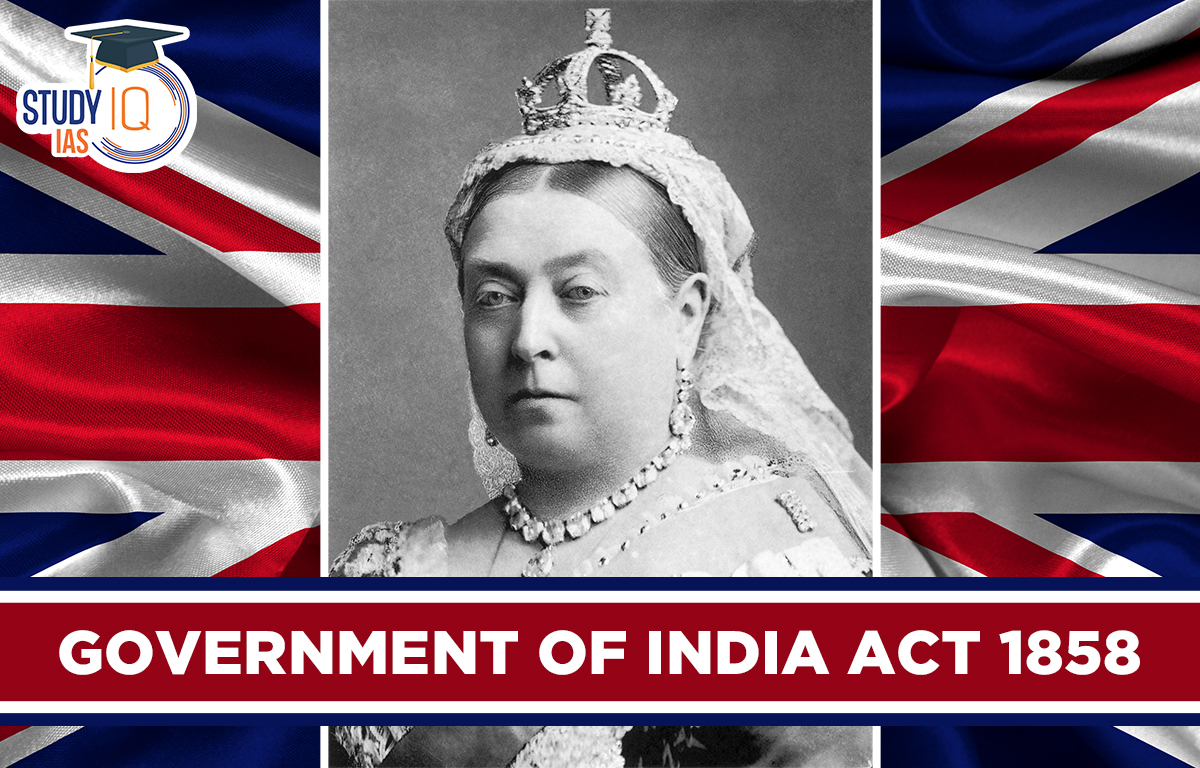Table of Contents
Government of India Act 1858
Read all about Government of India Act 1858. On August 2, 1858, the British Parliament approved the Government of India Act 1858. The British Parliament will transfer the East India Company’s management of British India to the Crown. Following the 1857 Revolt also referred to as the First War of Independence or the “sepoy mutiny,” this important Act was approved.
The “Act for the Good Government of India” is another name it is known with. The Dual Government Scheme under Pitt’s India Act was stopped. The Government of India Act 1858, which is crucial for UPSC Indian Polity Preparation, is explained in this article.
Read about: Charter Act of 1793
The Government of India Act 1858 History
Despite being put down, the 1858 mutiny shocked London. It conveyed the idea that trading companies shouldn’t be allowed to continue acting as a political power. Many English traders and residents had also grown invested in India since 1853, and their constant criticism was that the corporation had been ignoring their interests.
The twin government’s cumbrous, complex, and irrational nature, in the opinion of British Prime Minister Palmerson, was one of the Company’s fundamental flaws. On August 2, 1858, Parliament passed the Government of India Act, transferring British rule over India from the East India Company, whose negligence was primarily to blame for the uprising, to the crown. This occurred less than a month after Lord Canning declared the victory of British arms.
The British Crown’s authority in India took precedence over the Company’s rule, and the Secretary of State for India was responsible for exercising that authority.
Read about: Charter Act of 1833
Government of India Act 1858 Provisions
The East India Company was shut down. The country’s Indian territories were to be under the control of the British queen. The deed gave India control over a British colony. The establishment of the Indian civil services was intended to facilitate the efficient operation of the nation’s government. There were guidelines for the enlistment of Indians.
The Pitt’s India Act of 1784’s dual government proposal was repealed along with the idea of lapse. The British East India Company’s Board of Control and Court of Directors were abolished. The Secretary of State for India was given control over the company’s board of directors’ authority (First Secretary of State for India: Lord Stanley)
A council of 15 members was to assist the secretary of state. The council’s function was purely advisory. The Council’s chairman was appointed as the Secretary of State for India. Additionally, the Secretary of State would serve as a liaison between the Indian Administration and the British government.
The Indian Administration would be under the sole direction and control of the Secretary of State. Additionally, he had the authority to communicate with India in confidence without first consulting his council. The secretary of state could be questioned by the British Parliament about the situation in India. The Governor General/Viceroy served as the British government’s envoy in India. The Crown appointed the Viceroy and the Governors of the various presidencies. An Executive Council was to provide assistance to the Viceroys.
Additionally, it was decided that the other Indian princes would maintain their independence as long as they consented to British suzerainty and authority. All the Indians who took part in the mutiny would receive pardons, with the exception of those who had killed British citizens. To run the nation, the Indian Civil Services was to be created. There was a clause that allowed for the inclusion of Indians in the military.
Read about: Charter Act of 1853
Government of India Act 1858 Features
Viceroy of India has replaced the previous title of Governor-General of India. The British Crown’s official representative to India was changed to the Viceroy of India. The Board of Control and Court of Directors were eliminated by the Government of India Act 1858, which put an end to the dual government system. In addition to causing the Viceroy of India to be remove.
The Secretary of State for India was a new position created by the Government of India Act who reported directly to the British Parliament. The Government of India Act created the 15-member Council to support the Indian Secretary of State. This Council served as a consultative body for him. The Secretary of State was appointed Council Chairman.
Read about: Indian Councils Act 1861
Government of India Act 1858 Limitations
Absolute Imperial power predominated, and the Indian people were not represented. The British parliament was the sole body to whom the Secretary of State had to answer and had complete discretion over how India was run.
Read about: Indian Council Act of 1892
Government of India Act 1858 UPSC
The Good Governance Act of 1858 is sometimes referred to as the Government of India Act. The East India Company will be transferred administrative control of British India by Parliament. The Pitt’s India Statute of 1784’s envisaged dual governance was repealed by the act, which also declared India a direct British colony. The Indian government’s structure was unaffected in any way. The majority of the rules were put into place to protect the crown jewel of the British Empire from any potential threats or uprisings. This article has all the details about Government of India Act 1858 for the UPSC Exam Preparation.


 Nagari Pracharini Sabha Revival: Backgro...
Nagari Pracharini Sabha Revival: Backgro...
 Ryotwari System in India, Features, Impa...
Ryotwari System in India, Features, Impa...
 Battle of Plassey, History, Causes, Impa...
Battle of Plassey, History, Causes, Impa...





















